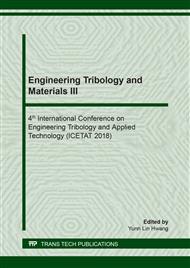p.69
p.75
p.81
p.91
p.97
p.105
p.111
p.117
p.123
Vibrothermographical Simulation of Cracked Structures
Abstract:
This research performs finite element simulations of cracked structures undergoing the vibrothermography process, which is an experimental technique gaining popularity for structural damage identification. In vibrothermography, a vibration shaker is used to excite the test structure. If the structure has cracks or defects, frictional heat will be generated at those cracks and thermal images can be recorded by an infrared camera. The vibrothermographical simulation includes modal analysis, transient vibration and transient thermal analysis. Two simulated examples are presented in this work: the first one is an aluminum-alloy plate with a hairline crack; the second example is a brake rotor with a hairline crack on one of the bolt-hole surfaces. Although higher modes are usually more difficult to excite, they may be used in vibrothermography to detect structural cracks more efficiently.
Info:
Periodical:
Pages:
97-104
Citation:
Online since:
September 2019
Authors:
Price:
Сopyright:
© 2019 Trans Tech Publications Ltd. All Rights Reserved
Share:
Citation:


